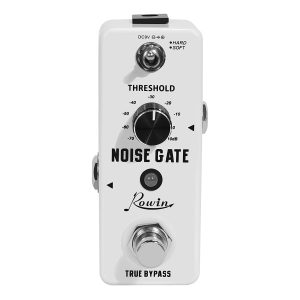
- 2 Modes – Hard And Soft
- Adjusting The Noise Reduction Degree -70 — +10 Db
- True Bypass
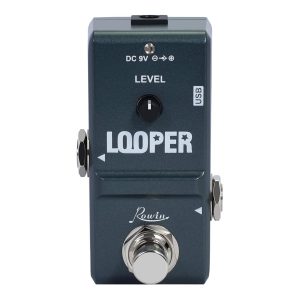
- Usb For Upload And Download
- One Key To Achieve Almost All Of Functions
- High-Quality Zinc Alloy
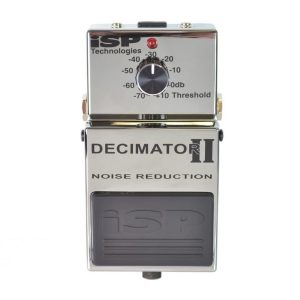
- Ultimate Noise Reduction Pedal
- Tracks The Guitar Signal Directly From The Guitar
- Includes a LINK IN & LINK OUT
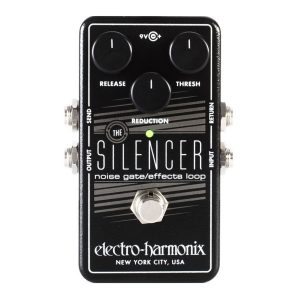
- Buffered Bypass
- Delivers Up To -70 DB Of Noise Reduction
- Use It As An Inline Noise Gate
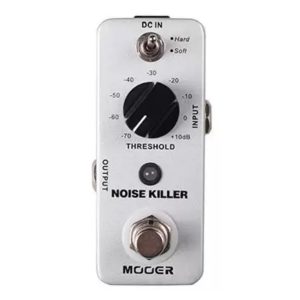
- True Bypass
- Very Small And Exquisite Full Metal Shell
- Soft And Hard Mode
Choose the Best Noise Gate Pedal for Metal
Customer’s Choice: the Best Rated Noise Gate Pedals for Metal
33 users answered this survey. Please help us improve this review!
Noise gate pedals have become a must-have to manage unwanted noises while preserving the sound and feel of your playing. These stompboxes may be set to meet the preferences of the user, allowing you to minimize any undesired noise. Manufacturers have recognized their popularity, and all of the major pedal companies offer at least one gate effect pedal in their lineups.
Are you a metal guitarist? You know that sometimes the sound of your guitar can become too loud, even with distortion. This is where noise gates come in! Noise gates are pedals that help reduce the volume on your guitar when it falls below a certain threshold.
They are perfect for metal guitarists because they allow you to preserve the sound of drums and vocals while keeping your guitar sounding great at all times. If you want to find out more about these types of pedals, read this guide!
Table of Contents
Rowin Guitar Noise Suppressor Effect Pedal – the Editor’s choice!
 The Rowin noise gate pedal is a competent noise gate with good results. The makers of high-quality pedals are responsible for it. The objective of the developers was to create a high-quality pedal at an affordable price that everyone could afford.
The Rowin noise gate pedal is a competent noise gate with good results. The makers of high-quality pedals are responsible for it. The objective of the developers was to create a high-quality pedal at an affordable price that everyone could afford.
They also give excellent after-sales service to all customers. One advantage of using this Noise barrier is that it works effectively in reducing noise from the input signal while preserving the sound’s genuineness.
The essential features of this noise gate are its low-noise design and premium components, which help to preserve your sound’s individuality. It has two operating modes: hard and soft effect.
This device is lightweight and attractive, incorporating a full metal casing and true bypass, just like other high-performance effect pedals. It also has an indicator that displays the gear’s operational status.
Rowin Tiny Looper Effect Pedal – the best looper pedal!
 Introducing the Rowin Tiny Looper! This electric guitar effect pedal is perfect for creative musicians who want to overdub and create seamless loops with ease. It’s made of high-quality zinc alloy and is very durable and sturdy, so you can rely on it for years of use. Additionally, its tiny size makes it easy to take with you wherever you go.
Introducing the Rowin Tiny Looper! This electric guitar effect pedal is perfect for creative musicians who want to overdub and create seamless loops with ease. It’s made of high-quality zinc alloy and is very durable and sturdy, so you can rely on it for years of use. Additionally, its tiny size makes it easy to take with you wherever you go.
The Tiny Looper also features unlimited overdubbing, 10 minutes of looping time, undo/redo/delete options, and USB port support so you can easily upload and download music files from your PC.
The looper’s most appealing feature is its footswitch. In addition, it delivers clear audio because it has been designed with the built-in true bypass support to produce unaltered looped sounds.
It’s easy to use, and the price is reasonable. The owner’s manual includes all of the necessary information. The push-button mechanism works perfectly, and you don’t have to force it to work. Even though the looper is small, the volume knob is large enough for simple operation.
ISP Technologies Decimator II Pedal – the best for easy operation!
 The noise reduction pedal is one of the company’s most popular pedals for a reason. This device is the second version of the original Decimator, and it has earned a good name among guitar experts.
The noise reduction pedal is one of the company’s most popular pedals for a reason. This device is the second version of the original Decimator, and it has earned a good name among guitar experts.
Plus, with its improved design, the Decimator II delivers unmatched performance and noise reduction. Simple to use and reliable, this pedal is a must-have for any guitarist looking to get the most out of their sound.
This popular pedal is powered by a 9V battery or a standard DC power adapter. In addition, it may be connected to another pedal and used to track the guitar input signal. Two Decimator II pedals can be operated in tandem, as can two Decimator II pedals with separate effects loops. For example, one before the preamp and one in front of the effect loops are common setups.
The pedal eliminates noise without cutting or coloring the tone, from a “set and forget” pedal to taming unruly single-coil ups or hi-gain amps. It’s one of the most popular noise reduction pedals, and you’ll understand why once you see it in action.
Electro-Harmonix The Silencer Pedal – the best for noise reduction!
 Do you need to tame the noise in your signal chain? The pedal from Electro-Harmonix could be just what you need. Featuring an adjustable reduction range and release control, it gives you precise control over your sound. Plus, it’s compact and rugged enough to take on the road.
Do you need to tame the noise in your signal chain? The pedal from Electro-Harmonix could be just what you need. Featuring an adjustable reduction range and release control, it gives you precise control over your sound. Plus, it’s compact and rugged enough to take on the road.
The Silencer can be used as a regular inline noise gate or to gate an entire loop of effects, which is one of its most distinctive features. It’s also a “buffered bypass” pedal, which means you may retain the effects loop even when the pedal is bypassed.
The EHX Silencer is the most affordable of the full-featured noise gate pedals. It might have been a candidate for our top pick, but we discovered that the Boss and ISP Decimator II are more steadfast in construction quality and unflinching in performance. Nonetheless, it provides outstanding noise reduction at this price range.
Mooer EQ Effects Pedal – the best for durability!
 Mooer’s EQ Effects Pedal is perfect for anyone who wants to fine-tune their sound. It offers both hard and soft modes, so you can choose the amount of noise reduction that’s right for you.
Mooer’s EQ Effects Pedal is perfect for anyone who wants to fine-tune their sound. It offers both hard and soft modes, so you can choose the amount of noise reduction that’s right for you.
Mooer’s EQ Effects Pedal is a great, affordable way to reduce noise in your signal chain. With its hard and soft modes, you can get the perfect amount of noise reduction for your tone. And with its small size and true bypass, it won’t affect your tone when it’s not needed.
In addition, it’s very small and exquisite, with a full metal shell, making it a great addition to any rig. And best of all, it comes at an amazing price!
The Mooer pedals are well-known for their affordable pricing and simplicity of use. As a result, I would strongly suggest this pedal to beginner guitarists who aren’t familiar with effects pedals or audio processing. It’s an excellent place to start for anyone wanting to get used to the idea of equalization.
The Buyer’s Guide
The Definition of the Noise Gate Pedal:
Threshold
This is the point at which you begin to allow sounds through without the use of any reduction. The louder your undesired noises are, the higher you’ll need to raise this, but it’s crucial not to inadvertently eliminate anything you want to hear.
If you set it too high, this may prevent these notes from passing through. And it means that it can defeat the purpose of playing them in the first place.Decay
You should understand it as something that determines how quickly the noise reduction kicks in.
A slow decay, on the other hand, will produce an incredibly tight sound but might seem unnatural. If you simply want a brief noise to fill in before it cuts out (in order to make it sound a bit smoother), consider applying a slower decay.
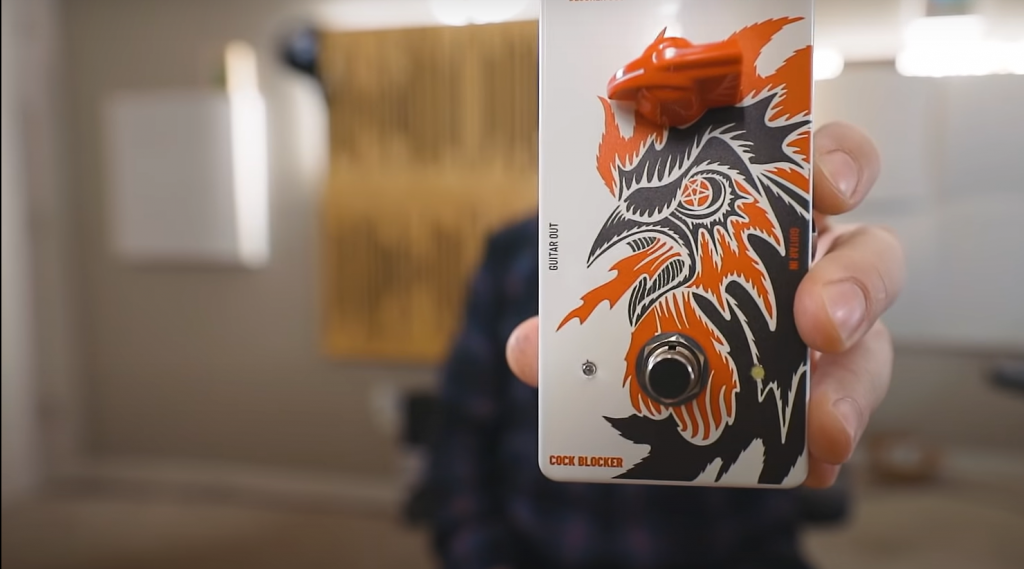
Nevertheless, setting the decay too slow may not be effective as well. Higher-end pedals automatically adjust the decay to your playing style [1].
Benefits of This Gate Pedal:
Noisy Equipment
As your rig grows, so does the number of pedals you need to manage. The more pedalsa guitarist adds, the more muddled your tone becomes. Some pedals are intended to give your guitar a noisy sound, but they end up distorting the whole signal, which causes your notes to not penetrate as clearly as they should.
Gates reduce low-signal interference while still allowing your strings to ring undistorted, as they do with other voodoo mods.
Another problem is when you’re gigging and you come across some shady mains power that produces a loud buzz or humming through your amplifier. A gate will keep this noise from ever reaching your amp by just refusing to allow it through. All you have to do now is adjust the threshold correctly.
Remove Fret Noise
Is there a noticeable swish as you move from string to string? Some people adore it, while most (including me) despise it. If you dislike the sound, a gate will take care of it.
Setting a high threshold and a fast decay will produce a clear sound between notes, which is ideal if you don’t like that sliding sound between frets or if you want the ultimate staccato.
Mitigating Amp Static
The primary advantage of noise gate pedals is that they are incredibly useful for preventing static noise when you’re playing. When you’re performing away and have just completed a huge solo or are in the midst of chord stabs, having a noise gate pedal connected to your gear automatically silences the static hum that your guitar and amp produce by themselves.
High Gain Players
If you’re a high-gain player, your usually super-tight riffs may not seem as tight. The gap between your notes is preventing you from sounding like the sharp player you are. Yes, it’s true. Some of these items on our list (e.g., the MXR Smart Gate) recognize when the notes you play require a longer decay time.
Easy to Use
Another advantage of these pedals is that they’re really simple to use. Simply connect them into your pedal chain and adjust the activation level. When the signal and sound levels you create fall below a certain threshold, your noise pedal gate will automatically activate [2].
What is the Noise Gate Effect?
A noise gate is similar to a compressor and an all-pass filter on an equalizer. The issue is that equalizer pedals don’t include all-pass filters, necessitating the use of this additional device in your arsenal. A compressor pedal may also make your noise more apparent without it.
Otherwise, all electrical noise and hum, as well as low-volume noises, will be muted.While there are undoubtedly better methods for cleaning up an audio track, this one is still used by most engineers. It’s the sound you hear when a noise gate effect is added to a song. Even if every track has undetectable amounts of noise that you’d never notice while listening alone, when combined, these noises can build up and be heard in the final mix.
Between songs, you may use a silent click to reduce any ambient noise that might be in your signal. This procedure is especially important if you’re playing music in environments where there are people talking or laughing. If set carefully, this technique can ensure that no extra noise whatsoever enters your amplifier between notes or phrases.
Many individuals will forgo the advantages because they are too lazy to set it up (yes, you must reset it each time and in each location depending on how you’re playing that day or that hour), but having this pedal early in your setup gives a clear feed to your other effects and amplifier, which everyone will appreciate [3].
What Makes My Signal Noisy?
There are varieties of elements that may have an impact on the signal path of your guitar. There shouldn’t be much noise if you’re plugged in but aren’t playing, but if your pre-amp/amplifier sounds like you’re in the middle of a shower, there’s probably something wrong with it. Here are some possible reasons why:
Effects Pedals
If you’re a guitar player who uses a lot of effects pedals, they can make your signal noisy. Gain pedals, in particular, can be a major problem since they boost your guitar signal. They are defined by their ability to raise the noise level on your signal.
Noisy Pickups
Pickups on some guitars are especially sensitive to noise and buzz than others. Single coil pickups are particularly notorious for causing noise, which is why humbucking pickups were created in the first place.

There are times when a humbucker just won’t do. They have a fuller and warmer sound, and it’s difficult to get that single-coil snap. If this is the case, a noise gate pedal may be useful in keeping ambient noise under control.
Power Supplies
Many pedals on a pedalboard are powered by an AC power adapter, which can supply electricity to several devices via many leads that join from the same power source. This type of noise is very typical, and it’s caused by a low-quality or failing power supply or one that becomes worse with time.
Main Features:
Type
Not all gates are created equal. The majority of these pedals attempt to eliminate a variety of noises; you establish a volume level at which noises should not be heard, and the decay – and the pedal takes care of the rest.
Single-coil pickups, on the other hand, have a reputation for being noisy, but there are a few pedals that just focus on lowering them. They’re particularly made to cut down on the hum of these pickups and usually feature very basic controls.
Other gates, on the other hand, are anything but simple. They utilize sophisticated technology to calculate the duration of your notes and mold them appropriately. This is ideal for high-gain musicians who require spaces between notes in specific locations.
Send and Return Jacks
Some people who are more technologically savvy prefer to utilize the send and return options. These allow you to eliminate pedals that produce unwanted hum or hiss (for example, distortion pedals). If you’re going to do this, make sure the pedal you purchase has send-and-return jacks.
Interface
Sometimes they are referred to as “audio interfaces” or “USB Audio Interfaces”.
The interface is also where you will plug your headphones into. It’s best if the interface has headphone outputs on it, especially since some noise gate pedals do not have this feature built-in. This ensures that there won’t be any unwanted feedback coming through while recording and practicing with the pedal.
Each one of these features can introduce more background noise into your signal chain so it might just be worth looking for an interface without all of those bells and whistles.
Some noise gate pedals come with an interface built-in, so check to see if that is the case. If not you will need one separate from your pedal.
Modes of Operation
Noise gates are available in two different types: analog and digital. Analog noise gates use a filter to reduce or eliminate unwanted sound signals. Digital noise gates use software to achieve the same goal as an analog noise gate but typically offer more features than an analog model.
A noise gate pedal can have one of three modes of operation: auto, manual, and latch.
The most common mode is the automatic mode. This mode detects when you are playing and engages the noise gate. When you stop playing, the noise gate disengages. The manual mode requires you to engage and disengage the noise gate yourself with a switch on the pedal. The latch mode keeps the noise gate engaged until you manually disengage it.
There are three different types of filters that can be used in an analog gate:
- high-pass;
- low-pass;
- band-pass;
The high or low pass filter is used to reduce or eliminate noise from either the high or low frequencies in an audio signal. The band-pass works by cutting off all of the lows as well as both sides of highs outside a certain range to only allow the desired frequency through for reduction. In essence, it’s kind of like using a pair of headphones at half volume without music playing just your guitar.
Dimensions and Weight
Noise gates are available in a variety of sizes and weights. The dimensions, materials used, knobs, or switches on the pedal all contribute to what your needs are as well as your budget.
The size of the noise gate is important if you plan on using more than one effect at once because pedals can’t be stacked without an A/B switch that allows for easy switching between two effects with only one input or output jack.
If this isn’t something you’re concerned about then it won’t matter so much how large the pedal is unless space becomes an issue for where you want to put them on your board. It may also affect how often they need to be replaced since larger units tend to last longer due to their increased durability compared to smaller pedals.
The weight of the pedal is important if you plan on traveling with it or moving your setup around a lot because they can add up quickly and become cumbersome to transport, especially for gigs where you may have to travel several miles from your car to the stage or studio each night.
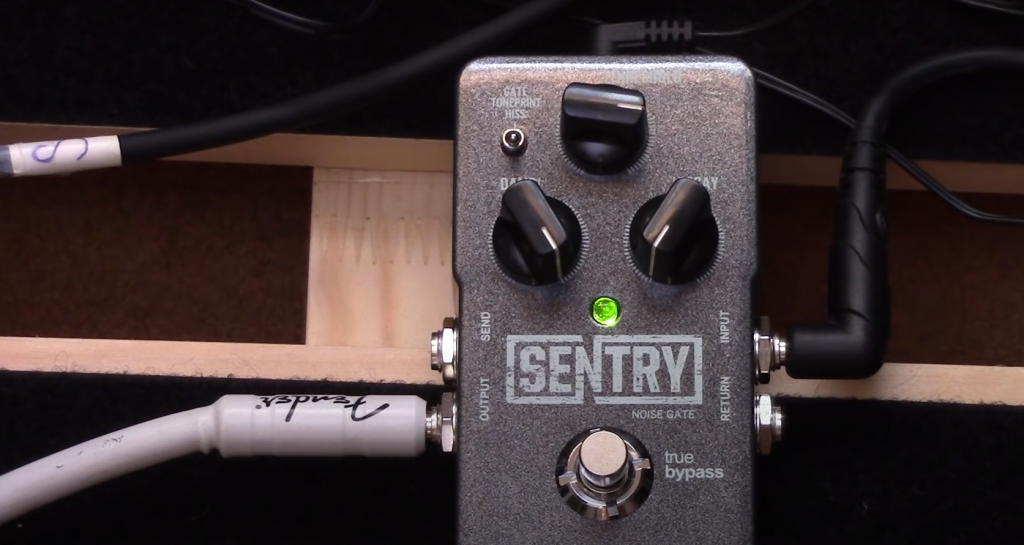
In general, digital noise gates are significantly lighter than analog models but this isn’t always true so be sure that any specifications about the size and weight apply only when considering a particular model’s features in addition to its materials used in construction which will affect how durable it is as well as overall weight.
Noise Gate Pedal Controls
The most frequent controls on a noise gate pedal are three, although they are not always present:
- Threshold. This control, as previously said, controls when the gate opens and closes depending on the signal passing through it. A low threshold will provide your system with an airtight sound by eliminating almost all unpleasant or superfluous noise. A high threshold, on the other hand, will be more selective in its removal of the most abrasive components of your signal;
- Decay/Release. The gate will close after the desired duration has passed if you don’t manually close it. If the decay is set low, the gate will shut immediately as soon as your signal reaches the required level, giving it a chopped, almost robotic sound. Setting it to high gives it a quieter sound with a closing gate that closes gradually for more natural tightness;
- Reduction. The amount by which the gated signal is decreased is determined by this. As the name implies, it decides how much of the noise is eliminated. If you set it to high, you’ll be able to barely hear any noise; if you set it to low, though, you’ll keep some humming for a rough-around-the-edges feel;
Price and Warranty
The price of a noise gate pedal can vary, but they are typically affordable. Most pedals come with a warranty from the manufacturer, which can provide peace of mind when making your purchase. The warranty lasts about one year, which is not very long.
The price range can be anywhere from $100-$300 depending on what type of sound you’re looking for but overall you think they are fairly priced because these types of pedals really do help perfect my guitar tone
Extra Features to Look For:
- Amp of choice. When solid-state amps become older, they tend to make a louder buzzing noise. If you’re using an analog or high gain amplifier, expect a buzz;
- The amount of volume and gain. Every amp produces some static, which is unavoidable. However, if you increase the volume or gain, you’ll notice that your amp produces a lot more;
- EQ settings. If you’re noticing a lot of noise in your amplifier, consider boosting the mid and treble frequencies. Any undesirable noise generated by your amp will be reduced;
- AC supply and other interference. You might not think of it at first, but the quality of your main power supply has a bearing as well. If the quality of electricity is poor, your rig will produce a considerably noisier sound;
- Radio and static. AMPs are susceptible to electromagnetic interference, usually from electrical appliances (such as televisions), cell phones, Bluetooth, and two-way radios;
How Do You Use a Noise Gate Pedal?
You won’t have to worry about the difficulties of an effects loop or the entire signal chain with a noise gate. Obviously, you want the gate to appear early so that the remaining effects are not affected by any noise that may have gotten through.
Where to Place it in the Signal Chain?
It’s all too easy to get side-tracked by the order of the effects chain and overlook where you want your gate to appear in relation to all of your other guitar pedals:
- Dynamics, filters, and pitch shifters;
- Boost and distortion;
- Modulation;
- Time;
Noise gates are a type of dynamic control, and they should be used at the very front of your signal chain, even before compression, but you may use them after if you’re worried about sustaining. Before other effects begin to act on it, you want all noise out of your signal.
Understanding the Knob Settings
The most basic type is the standard WEMO pedal. It’s simple to figure out, but not to use because it has a Threshold knob that controls the volume level beneath which everything is silent.
Others will allow you to control the Release or Decay so that there is a smooth transition back into the main signal, but most manufacturers provide attack and release settings that usually work out just fine. Others with Mode controls will let you minimize noise without affecting sound quality.
Do You Actually Need A Noise Gate Pedal?
If you have a lot of undesirable noise in your signal, then yes, you should unquestionably acquire one. The greatest approach to clean up your output is with a noise gate.
Pedals have optimum settings, as with any instrument effect unit. There are a variety of settings that need to be adjusted for it to perform at its peak. Some pedals just require a threshold knob to adjust. Others may take some more effort to dial in the ideal sound.
Setting the threshold too low might cause some of the noise to remain visible when you’re not playing. Setting it excessively high may limit your sound and eliminate important components of your signal, potentially altering your fundamental tone.
While noise gates do, in fact, eliminate unwanted sounds and overtones when you aren’t playing, it only happens when you’re not.
If you’re rocking out, any noise in your signal chain will be heard. A noise gate does not eliminate noise but rather filters to a set level. The whole signal will come through once you start playing.
Where Does A Noise Gate Pedal Fit In The Signal Chain?
There is no one-size-fits-all solution to this since every guitarist’s signal chain is unique. That’s especially true if you have a lot of effects pedals to consider.
A noise gate pedal is most effective when used after gain effects like distortion or overdrive, but before any reverb, delay pedals, or time-based effects.
When you use the threshold control, a 0dB setting is used. This ensures that the excessive noise levels produced by utilizing a gain device (for example, distortion, overdrive, fuzz, or a clean boost) are eliminated before the time-based units deal with them.
Which Is Better: A Rack Mount Noise Gate Or A Noise Gate Pedal?
There are advantages and disadvantages to each, and in the end, it all boils down to what is finest for your circumstances.
A rack-mounted unit has more real estate to accommodate a larger circuit board and, as a result, a more complex circuitry design. A rack-mounted device may have more configurable features and, in some cases, a cleaner signal overall, especially with the higher-end studio equipment.
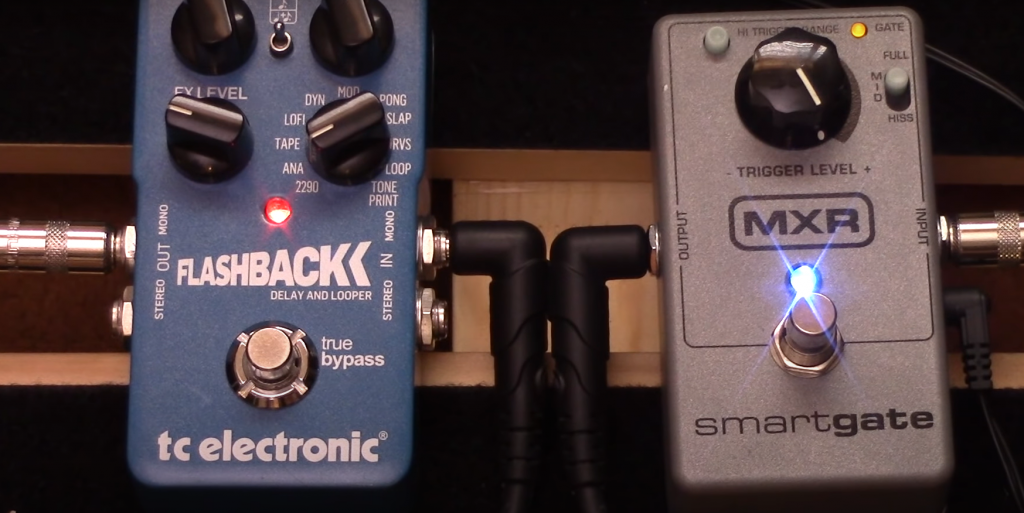
If you don’t rack mount any other effects, mobility may become an issue. It’s also difficult to alter settings on the fly, which is why so many of these micro-sized pedals are created.
While a pedal is undoubtedly portable, it shares the same problems as other pedals on your board, such as faulty patch cord connections and power supply difficulties. Tweakability, on the other hand, is typically easier since you can simply bend over and fiddle with the knobs whenever you need to.
Noise gate pedals aren’t as feature-rich as rack mount units. Because the whole circuit must fit in a smaller space, it may not compare to rack-mounted noise gates in terms of sound quality [4].
FAQ
Is a noise gate pedal essential for metal guitarists?
Noise gates are used by almost all professional metal band lead and rhythm guitarists, according to Quora users. Buzzes between songs are common with high-gain amps without a noise gate. When not playing, any amplifier with a lot of “crunch” in terms of gain might be loud enough to be noisy, therefore a good transparent noise gate is essential for any rock or metal musician [5].
Are branded pedals more reliable than others?
Pedals with logos are generally more dependable than low-cost, generic pedals. While there are some decent options from mass-produced Chinese firms or other countries, it is worth seeking a reputable company. Boss, for example, despite the fact that you may pay a bit more for it has a long history of success and offers an assurance of dependability and durability. A good brand will also have greater credibility in terms of its guarantee [6].
What makes a guitar noisier than others?
Depending on the type of pickups installed, you may get less or more hum or noise. A humbucker is significantly quieter than a single-coil pickup, as the name implies. A guitar with single-coil pickups will create more humming or noise than one with humbuckers.
If you have a guitar with single-coil and humbucker pickups, switching between them will result in a significant change in noise level.
The type of noise you respond to is determined by the tone you want to create. You may modify the pickups to produce less hum, but this will also change your sound. If you have a Telecaster (which is usually noisy), changing the pickups may make it appear to be a different guitar [7].
Where do you place a noise gate for metal?
In other cases, this is a matter of personal preference. Naturally, you’ll want the noise gate to be placed where the sound is loudest, such as after your fuzz pedal. It’s most common to place it at the end of your chain but before any ambient pedals like delay and reverb, however. Experiment a little to see what works best for you.
Some guitarists also like to place noise gates in front of their amps, but this can be tricky because if the gate is too sensitive it will start cutting off your signal when you’re not even playing.
Do noise gate pedals affect tone?
The amp’s hissing sound is caused by 60Hz vibrations, which come from the amplifier.
The second sort of noise is frequently referred to as “white noise” and stems from too much gain being fed into the amp via overdrive or distortion pedals. So, if you connect a new noise gate pedal to your rig and it has no effect on your tone, it’s possible that the pedal isn’t the issue. It might be anything from a thing or two.
You might be using unsuitable cables, or one of your pedals on the pedalboard is about to break down. Even if you set up the noise gate correctly, it won’t work unless you fix everything from the beginning. This brings us to the topic of properly utilizing a noise gate pedal [8].
Is a noise gate the same as a noise suppressor?
A noise gate mutes sound below a certain volume, but a noise suppressor eliminates them entirely. A studio noise suppressor can isolate specific frequencies, however, this isn’t often the case with pedal suppressors [9].
Is a noise suppressor pedal necessary?
This function is common in guitar processors, and it allows you to reduce noise by utilizing the noise gate option. Players who utilize pedals/amp distortion, on the other hand, will need a noise gate pedal to address this problem. The threshold and decay are two critical elements that influence any noise gate pedal [10].
Where do sentry noise gates go?
If you don’t need a delay or reverb, go for the end of the chain. Some people prefer to put their noise gates after high gain pedals like overdrives or distortions in order to limit the signal when these effects are used. When a lot of gain is pushed into the signal and the pedal activates, it can control this noise [11].
Should the noise gate go in an effects loop?
That’s why, in certain noise gates, such as the BOSS NS-2 Noise Suppressor for guitars, there’s a main input/output area to connect to an amplifier and an insert for inserting noisy effects into a separate loop for reduction at multiple locations in your signal path. After that point, putting a noise gate is likely [12].
What order should your gate pedals be in?
The effect pedalboard is a unique instrument in every way, so there are many different techniques to arrange it.
The following are some common effect placement recommendations for pedalboard setups in general:
The distortion and dynamics (compressors), filters, pitch shifters, and volume pedals are generally placed at the beginning of the signal chain;
Overdrive/distortion pedals are the next stage in this chain;
After that, modulation effects such as chorus, flangers, and phasers enter the chain;
Delays and reverbs, for example, operate best at the end of a signal chain;
Variable speed effects pedals can be used to create subtle changes in your signal chain by placing them at the beginning or end of the chain [13];
What is the difference between a noise gate and a compressor?
A noise gate silences the complete signal until you begin playing, then shuts off everything again when you quit. The faster gates do this better and use less tone. When you aren’t playing, a noise suppressor tries to filter out the noise, while a better gate does it quicker and with less loss of sound quality [14].
Which comes first: noise gate or compressor?
Another option is to vary the tempo as needed for each section of the song. Drums and percussion, on the other hand, should be played at a consistent tempo throughout a song. Playing drums and percussion at the same time can become monotonous after consecutively playing them for an extended period of time.
However, some guitarists put the compressor last to enhance their signal before it reaches the preamp of their amplifier. The disadvantage of this technique is that any hum or noise from other effects will be amplified by the compressor’s output gain. You can sometimes correct this by employing a noise gate before the compressor, but tone quality may be affected.
Putting your compressor first and utilizing a signal booster just before your amplifier might be a viable alternative for those who want to get the best of both worlds. Some guitarists prefer to put their envelope filter before the compressor to extend its frequency range so that it can have an impact on it. Experimenting is always encouraged, but placing the compressor first is advised [15].
What does a compressor pedal do?
A compressor pedal is a stompbox that smooths out the dynamics of your guitar playing. A compressor may amplify the output when you play something softly to make it more audible. The compressor dampens the attack of your pick for a smoother overall sound if you strike it too violently [16].
Useful Video: What’s The Best Noise Gate Pedal?
Final thoughts
Noise gates are a great tool for metal guitarists. They allow you to preserve the sound of drums and vocals while keeping your guitar sounding great at all times. Music experts have compiled this guide with everything you need to know about noise gates, including what they do, how they work, and some popular models on the market today. Hopefully, this guide helped you get up to speed on these handy pedals!
References:
- https://zinginstruments.com/best-noise-gate-pedals-review/
- https://guitarspace.org/sound-pedals/best-noise-gate-pedals/
- https://ledgernote.com/reviews/best-noise-gate-pedals/
- https://numusician.com/best-noise-gate-pedal/
- https://www.quora.com/What-metal-bands-use-a-noise-gate-pedal
- https://primesound.org/best-noise-gate-pedal/
- https://guitargearfinder.com/guides/faq-getting-rid-of-guitar-hum-buzz-and-noise-issues/
- https://guitarfella.com/using-noise-gate-effect/
- https://www.guitarguitar.co.uk/pedals/noise-gate/
- https://www.furtadosonline.com/blog/importance-of-a-noise-gate/
- https://guitarfella.com/using-noise-gate-effect/
- https://www.sweetwater.com/insync/where-should-i-put-my-noise-gate-in-my-guitar-signal-chain/
- https://www.strymon.net/setting-up-your-effect-signal-chain/
- https://www.ultimate-guitar.com/forum/showthread.php?t=1017489
- https://www.musiciansfriend.com/thehub/best-place-to-put-a-compressor-in-a-guitar-effects-chain
- https://www.masterclass.com/articles/guitar-101-what-is-a-compressor-pedal-learn-how-to-use-a-compressor-pedal

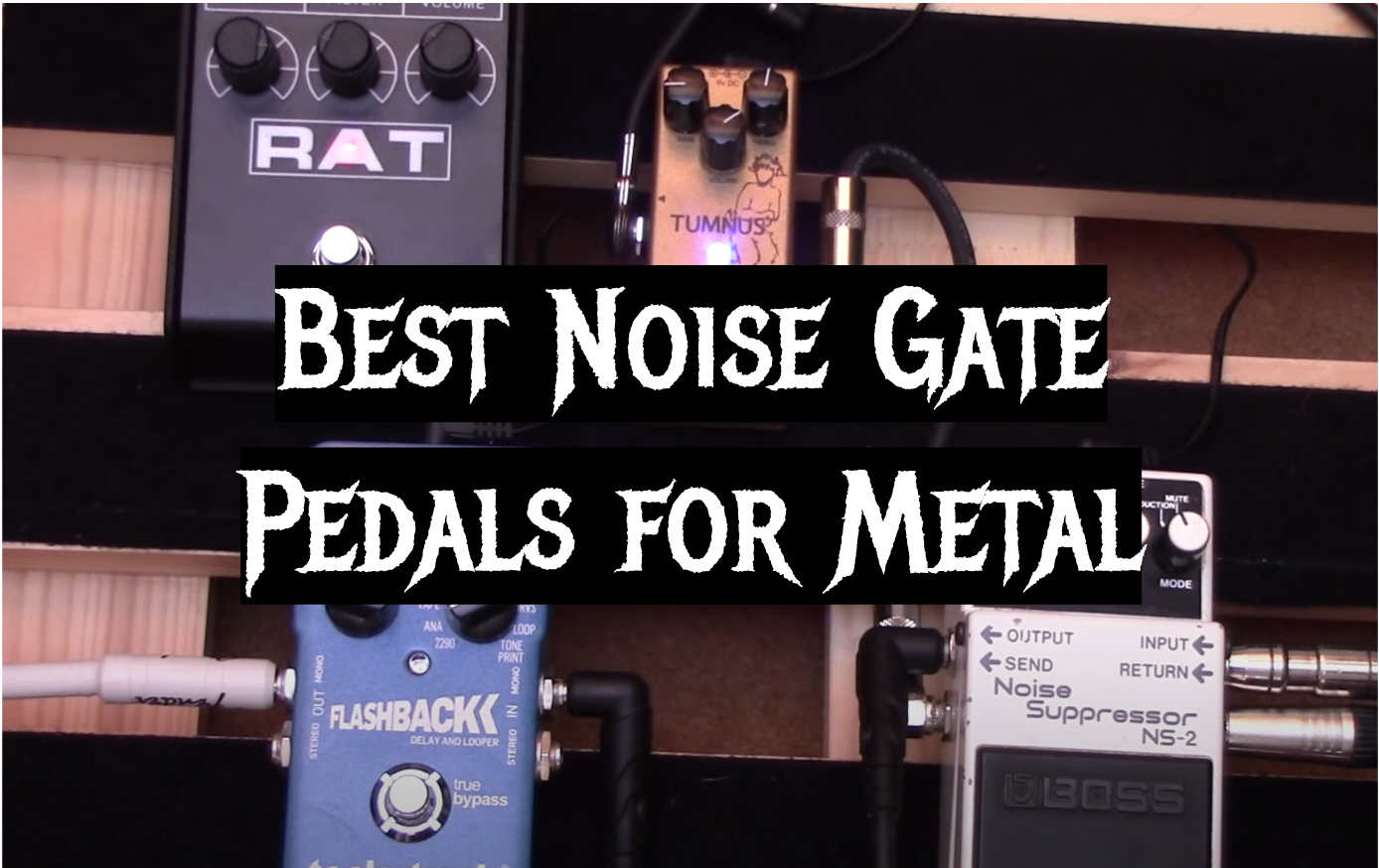
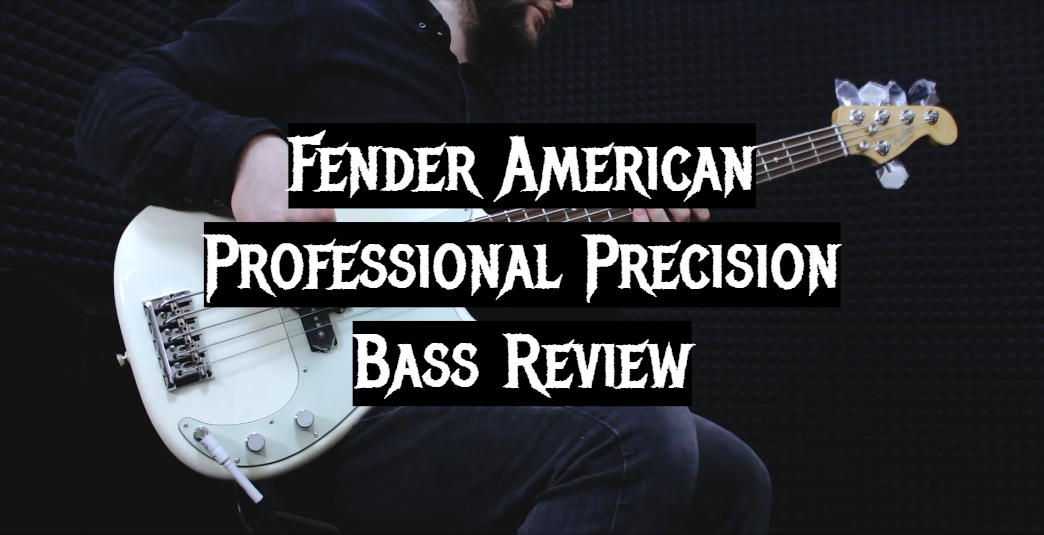

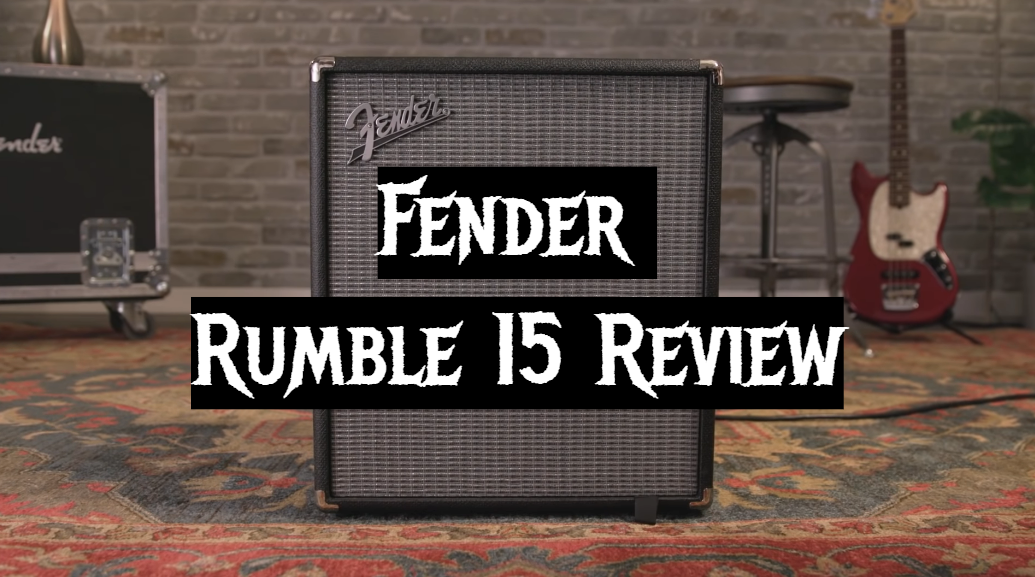
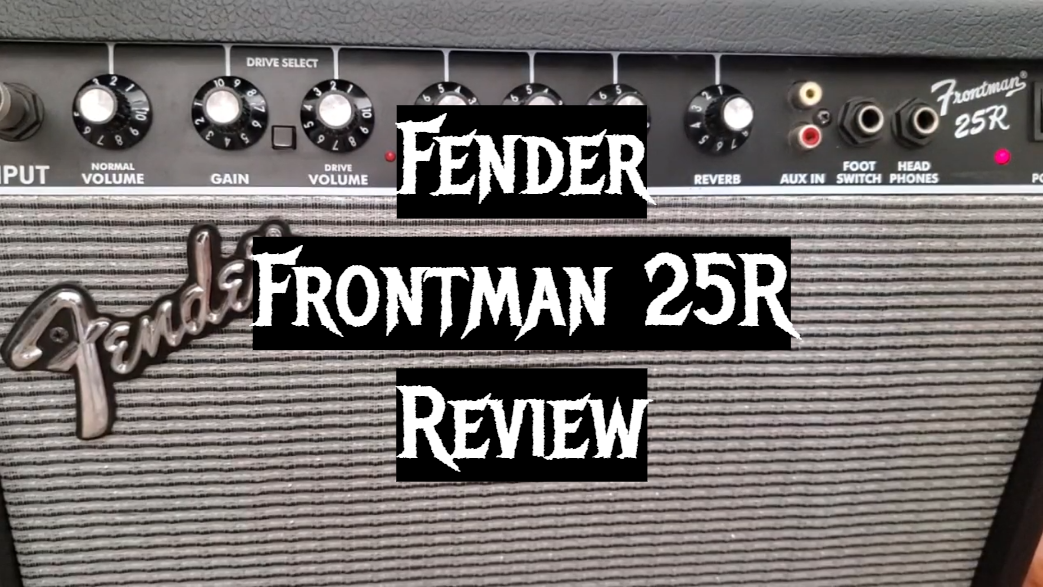
Leave a Reply